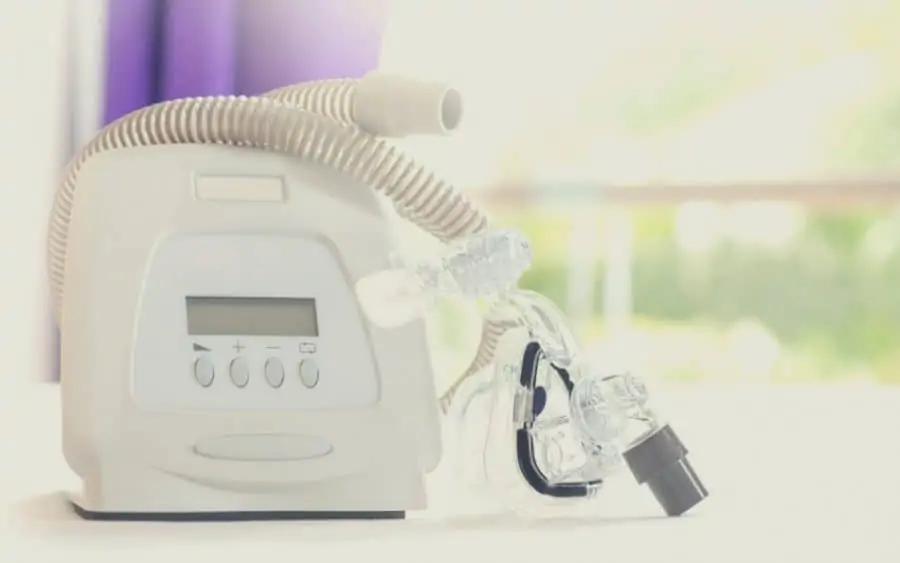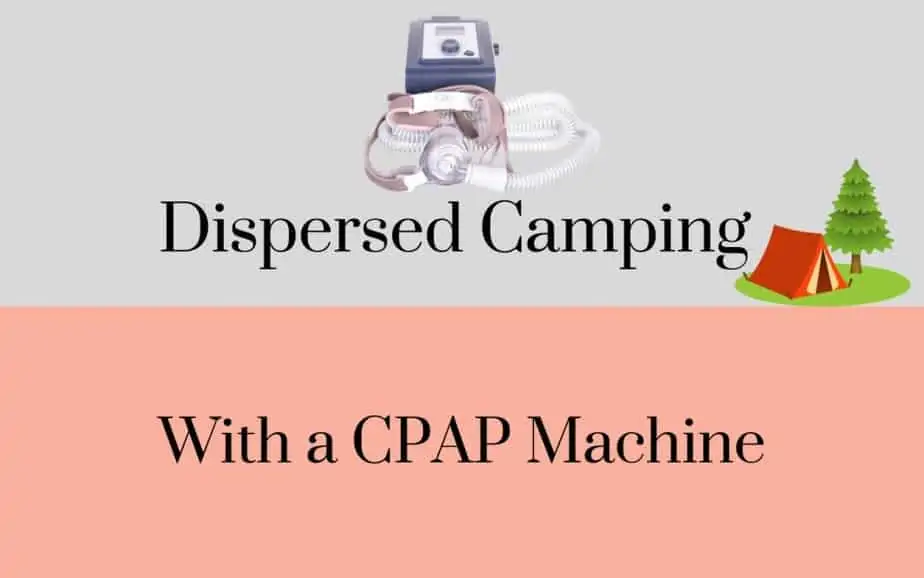Boondocking or Dispersed Camping With a CPAP Machine. Most people think that Memorial Day is considered the unofficial start of summer. Hey, it’s summer and more people want to hit the road in an RV. But some people are afraid because they use a CPAP machine and don’t know if they can.
This comes as no surprise why. Because, overall, people love to camp, relax, and reconnect with friends and family. Today the RVs are lighter and smaller, so more people are trying RVing for the first time!
If you’ve been RVing for years or are new to the road, you may feel tempted to skip your CPAP to go camping with sleep apnea. CPAP while camping might seem like an impossible task, but with a few modifications or accessories, it is possible to safely enjoy RVing.
Contents
Power a CPAP in an RV

Before you do anything, check your CPAP (or BiPAP) machine and review your power set up in your RV. Most CPAP machines run off of AC current, but some have a built-in plug for a DC current.
You need to remember, electricity is at a premium in RVs so you’ll need to be selective about what appliances you run while using your CPAP. Because your CPAP is essential to your health, it needs to be a top priority on your appliance power hierarchy.
CPAP on Shore Power
With shore power or by running a generator you can plug your CPAP into a 120 AC plug.
If you’re using CPAP on shore power, you’ll need to be selective about what appliances are also running.
Campgrounds offer either 30 amp or 50 amp and you don’t want to trip your breaker in the middle of the night. Your appliances will tell you their required wattage or amperage.
Some common RV appliances and electronics amperage requirements:
- Coffee maker – 8.3 amps
- Converter – 8 amps
- Hair dryer – 9 to 12 amps
- Microwave – 13 amps
- Refrigerator – 2.8 amps
Most motorhomes and trailers have a 12-volt outlet near the bed. You can either change the outlet to 120 Volt, run an extension cord from the nearest AC outlet or just buy a 12-volt inverter cord for your CPAP machine.
Boondocking with CPAP
Most CPAP machines are between 30-60 Watts. Watts is a unit of power and a function of current (amps) and volts (Watts= amps x volts).
If you’re running your CPAP off a battery, you need to know the power demand in ampere-hours. Obviously, you don’t want your battery dying in the middle of the night.
How to Find Amp Draw of a CPAP
The direct battery connection formula is Watts/volts=amp draw. So for a 30 Watt or 60 Watt machine, the calculation is
30 Watts /12 Volts = 2.75 amps from the battery.
60 Watts/12 Volts =5.5 amp draw.
To find amp-hours, multiply amp draw by the number of hours CPAP will run. Because you should use a CPAP for the entire time you’re asleep, you should calculate how many amp-hours you’ll be asleep.
So assuming that you have a 60 Watt machine, here is the calculation for amp-hours:
5.5 amps for 8 hours of sleep = 44 amps from the battery
5.5 amps for 10 hours of sleep = 55 amps from the battery
If you’re running an inverter, it draws some current too you should add 10% just to be safe.
60 Watts/12 Volts= 5.5 amp draw. 10%= 0.55 amps. Total amp draws with inverter= 6.05 amps an hour.
So for you to use a CPAP on a battery all night, you would need at least 48.4 amps for 8 hours of sleep.
CPAP Battery Options
Having a backup CPAP battery is a great idea. Your CPAP brand will have its own CPAP battery. You can usually buy or rent extra batteries from whoever supplies your CPAP machine. Most of these rechargeable batteries last for over 12 hours and are small and lightweight.
A more affordable but cumbersome option is to use a deep-cycle battery with a DC battery adapter. You can also bring a Serene life Portable Generator, with 155 watts of power. Just in case you need to charge your battery when a power source is unavailable. You can check the price here on Amazon
Travel CPAPS
Also, some of these machines come with a rechargeable built-in battery. These are great if you’re ever boondocking.
There are several different brands and models for you to pick from. Transcend, DreamStation, and ResMed just to name a few.
CPAP Cleaning
Clean CPAP machines and supplies help maintain the effectiveness of the treatment and help you avoid an infection. Cleaning your CPAP at home or in a motorhome follows the same process.
You should wipe your mask daily and do a deep clean weekly. The daily wipe down will prevent any bacteria from growing in your mask.
A deep clean consists of a bath of warm, clean water and mild soap. Add your mask and headgear and churn them around gently. Hang and air dry your items.
CPAP tubing doesn’t require a daily wipe down as long as you wipe your mask down. Follow the same bath procedure for the tubing as the mask.
Follow the recommended replacement schedule. Dirty filters are the number 1 culprit for a dirty CPAP machine. You’ll need to clean filters every day.
If you’re traveling with your CPAP, you should consider using disposable filters in case there isn’t clean running water to sanitize non-disposable ones.
If you have space, an automated CPAP cleaning device saves you time. These devices will help clean and sanitize your CPAP mask, but they do require power. Simply place your equipment in the sanitizing machine and remove them later, for a hands-free, space-saving way to keep your CPAP supplies bacteria-free.
The SoClean will take between 5-12 minutes to sanitize your CPAP mask. The SoClean will also run on dual voltage 110-240v and 50/60hz. If you are not hooked to shore power, then you would need a generator or inverter to run this. Check the prices here on Amazon.
The VirtuCLEAN takes a little longer at 30 minutes, but it might be ideal for an RV. Measuring in at 4.75″ L x 3.75″ W x 2.12″ it takes up very little space and it runs on a rechargeable lithium-ion battery. Each charge should give you around 7 full cleaning cycles before requiring recharging. You can check the prices on Amazon.
CPAP RV Storage
Bringing a new item onboard your RV can be challenging as space is limited, especially when everything has been organized. Purchasing a smaller, mini CPAP can help save space.

The Resmed AirMini is a lightweight, travel bag for smaller CPAP options for traveling. You can also put them in protective travel cases to protect them while driving. However, where do you store the CPAP in its travel case? This can sometimes be a problem as space is limited.
Will they fit in the overhead bin above the table, under the kitchen sink, or on a bathroom shelf? If space is limited you might consider getting a bed with drawers for storage built into the frame.
You could also use a caddy nightstand to place items beside your bed, like a hanging basket on the side of your mattress.
When you’re parked you don’t have to worry about storing your CPAP equipment, but probably still want it neatly out of the way.
To achieve this use suction cup hooks or command strips to hang up your mask and tubing when not in use.
Command Strip Cord Bundlers will allow you to actually wrap your hose up for nice and neat storage.
Preventing CPAP Condensation
If it gets cold in the night, colder than the temperature of the air passing through your CPAP hose then condensations could accumulate.
If enough moisture accumulates then it could actually drain towards your face for an unwanted splash effect during the middle of the night.
This issue can be prevented by heating your CPAP tube. You can use a hose cover, that fits over the tube to keep it warmer on the inside or purchase a heated tube that plugs directly into your CPAP machine.
If you have a CPAP with a humidifier you can adjust the settings as necessary to prevent condensation, however, if you’re on a humidity setting that has been prescribed by your doctor, check with them before adjusting it.
Always make sure you have enough distilled water with you on your trip to fill your humidifier chamber. And remember, a humidified one also requires power.
If you’re drydocking you might consider skipping the humidifier to save your battery. In all likelihood, you won’t need to use the CPAP humidifier during the summer anyway.
Don’t Skip the CPAP or Avoid the Road
CPAP therapy is essential for your health and safety. Studies show the dangers of lack of sleep. Drowsy driving accounts for nearly 20% of collisions and an untreated driver has a situational performance similar to someone with a BAC of .06-.08. You certainly don’t want to be impaired while hauling thousands of pounds.
With some simple changes and accessories, you can still enjoy camping even with sleep apnea.
Here is an article about generators this could also be a good way to go. Not only for your CPAP but also for your oxygen concentrator if you need one as I do.
Related Article about boondocking

